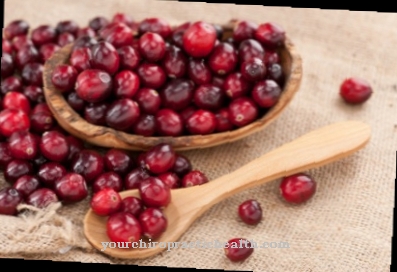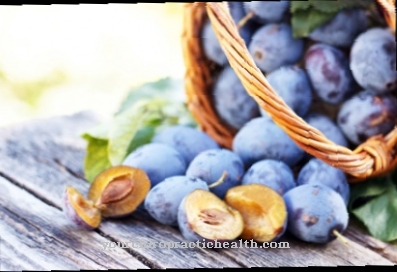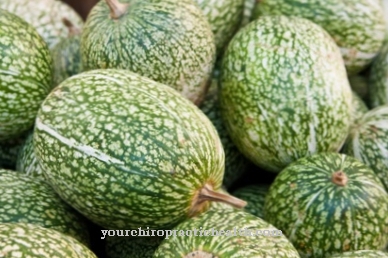The Adzuki bean (Vigna angularis) is a legume (Fabaceae, Leguminosae) of the subfamily Butterflies (Faboideae). The shrub-like crop is grown in East Asia and thrives best in subtropical locations. Your pea-sized fruits will too Red soybeans called.
What you should know about the adzuki bean

The adzuki bean has been cultivated in Japan, China and Korea for thousands of years. It is closely related to other beans such as the mung bean. More recently it has also been grown in South America, the southern United States, some African countries and New Zealand. In Japan, the adzuki bean is the second most important legume after the soybean. Depending on the cultivation intensity, yields between 4 and 30 dt / ha are achieved.
The mostly annual plants reach a height of 20 to 90 cm. The roughly pea-sized, dark red seeds grow in the legumes.They differ from the red kidney beans in their shape and a typical white line.
The ripe seeds are mainly used. The green pods are freshly processed into vegetables and salads. Some of the plants are also used as green fodder and fertilizer.
The dry adzuki beans have a sweet, nutty taste and are processed and used in different ways: The beans are canned or dried. Part of it is ground and the flour is processed into soups and pastries, jams, sweets and sweet drinks. In Japan a sweet bean paste (anko) is made from adzuki beans. The bean sprouts are sold as aduki. Popular desserts are the Shiruko soup and the Yokan confectionery made from ground adzuki beans, sugar and agar agar. In China, sweet bean paste is wrapped in flatbreads or made into an adzuki cake with syrup.
Legumes are much more important in Asian cuisine than in Western cuisine. The adzuki bean first came to the West as part of the macrobiotic diet. Adzuki beans are now available in dried form in Asia and organic stores.
In addition, the adzuki bean serves as food for cockatiels and was also used in a Japanese shower gel.
Importance to health
Adzuki beans are easier to digest than European haricot beans. With a protein content of 20 to 21 percent, they are among the vegetables with the highest protein content and supply the body with all essential amino acids, vitamins B1 and B2 as well as iron, potassium and calcium. Their dietary fiber promotes digestion, relieves the intestines and helps to lower the cholesterol level. Adzuki beans are also said to have antioxidant properties. A phytoestrogen is also said to have a preventive effect against breast cancer.
The adzuki bean is of great importance in traditional Chinese medicine (TCM). Due to its diuretic effect, it is primarily used for kidney and bladder problems, but also for all kinds of tumors, for overweight and in obstetrics. Since fear is associated with the kidney in TCM, the adzuki bean is also considered to be Courage bean. Another effect is the removal of heat, which is why the adzuki bean is used to treat inflammation. According to TCM, the adzuki bean combines cooling and draining effects and therefore counteracts damp heat. After all, the adzuki bean is useful for breastfeeding mothers as it promotes blood circulation and milk production and prevents breast inflammation (mastitis).
Ingredients & nutritional values
| Nutritional information | Amount per 100 gram |
| Calories 329 | Fat content 0.5 g |
| cholesterol 0 mg | sodium 5 mg |
| potassium 1,254 mg | carbohydrates 63 g |
| Fiber 13 g | protein 20 g |
Of all types of beans, the adzuki bean has the highest protein content and the lowest fat content. In addition to important minerals and trace elements, it contains 1,254 mg per 100 grams, a particularly high concentration of potassium.
100 grams of adzuki beans also contain:
- Vitamin A 17 IU
- Vitamin C 0 mg
- Calcium 66 mg
- Iron 5 mg
- Vitamin D 0 IU
- Vitamin B6 0.4 mg
- Vitamin B12 0 µg
- Magnesium 127 mg
Intolerances & allergies
Allergic reactions to legumes are common, but they can be very different. While the peanut can trigger extremely severe reactions even in traces, reactions to beans, lentils and peas - and thus also to the adzuki bean - are rare. If at all, they occur in weak, clinically irrelevant intensities. In this context, it is interesting to note that legume allergies can also arise from pollen sensitization, especially to grass pollen. The reason for this is the occurrence of allergenic proteins in different types.
People with histamine intolerance are generally not advised to consume legumes. Here you should check whether the adzuki bean triggers symptoms of intolerance.
Shopping & kitchen tips
Adzuki beans are usually commercially available dried. If stored in a cool and dry place, they can be kept for years. It is also possible to produce sprouts by germination. Adzuki sprouts must be blanched for about 5 minutes before consumption, as they contain poison when raw.
Casseroles and stews, but also desserts, are usually made from adzuki beans. Due to their sweet taste, the beans harmonize well with hearty vegetable dishes. Before boiling, they are soaked in cold water for 8 to 12 hours (preferably overnight). The soaking water is no longer used. The beans are placed on top with plenty of fresh water and cooked over a low flame. The cooking time is 40 minutes and may be longer if the water is very hard.
Salt and other spices are only added towards the end of the cooking time. The cooking process must not be interrupted. It is also possible to postpone the entire cooking process of the adzuki beans to the day before and to store them in the refrigerator until the respective dish is actually prepared.
The recommended amount as a side dish for two is 100 grams of adzuki beans.
Preparation tips
The simplest dish with adzuki beans is the 1: 1 mixture with rice known from macrobiotics - an easily digestible and invigorating dish. To do this, rice and adzuki beans are cooked on a very low flame for about two hours and only then seasoned.
For vegetable stews, the corresponding types of vegetables are added to the cooking process of the adzuki beans depending on the cooking time. Seasoning is always done at the end. Stews with pumpkin are popular - but there are no limits to the joy of experimentation.
For the sweet spread (anko), let 200 grams of adzuki beans cook for around 90 minutes on the lowest heat and add boiled chestnuts and cane sugar 10 minutes before the end of the cooking time. Then it is seasoned with orange peel and salt.
Sesame balls are made from rice and tapioca flour. Small pieces are filled with sweet bean paste, rolled into balls and rolled in white sesame seeds. Then fry the balls in hot oil.













.jpg)

.jpg)
.jpg)











.jpg)